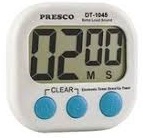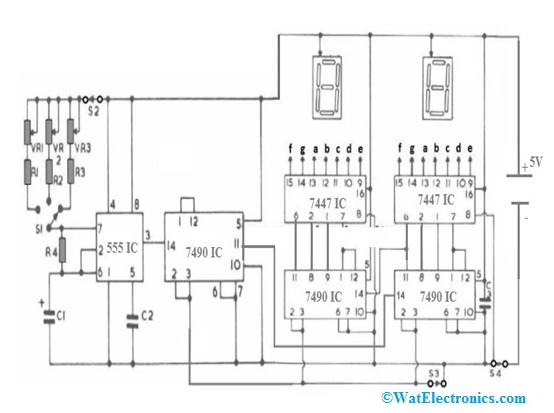At present in our daily life, Timers play a key role which is used in watches, clocks, or phones. With hectic plans, most people easily forget many schedules. So a digital timer is used to give an alert to remind you of your schedules like checking BP or take medications and many more. But in the industrial or commercial fields, these are not applicable. For new revolutions in electronic devices, the electronic industry has paved way for timers, loggers & controllers.
So from that, the digital timer is one of the inventions in electronics. In our everyday life, the most frequently used digital timer application is a microwave oven. The main function of timers is to fix the time for tasks whereas, in the industrial sector, it is used to estimate time to change production costs, etc. This article discusses an overview of a digital timer and its working.
What is Digital Timer?
A digital timer is a battery-operated small electronic device. The main function of this device is to count down minutes for precise timing. As compared to a traditional clock, these timers are much portable. Digital timers mainly range from simple type to complex which is portable, & includes complete operating systems.

Digital Timer Device
The manufacturing of digital timers can be done by different manufacturing companies. So Countronics is one of the best companies to make efficient timers with accurate measuring time. These timers are used everywhere because a lot of tasks can be made easily. Some timers include clocks as well as alarm clocks.
The working principle of a digital timer is, once you set the fixed time, the timer will generate a beep sound or vibrate at the drop of the specified time period. Also, it can be set to restart immediately to countdown & repeat the function of the alarm at normal intervals.
The digital timer construction can be done by using different electronic components along with the power source for a time like Secs, Mins & Hrs. Here the power source used for this timer may be a power cable or a battery. At last, the time is displayed on the LCD screen.
Different Types
Digital timer device suppliers provide timer meters, one-shot, delay-on/off, interval delay & recycle timers.
- Timer meters are employed in applications for displaying elapsed procedure time otherwise to track running time for factory equipment.
- Delay-on timers use a fixed time period to pass once the timer gets its input signal and output is activated.
- At the time the delay end, the contacts will release or shut. If the contact is NO (normally open), the load will strengthen at the time delay end. If the contact is NC (normally closed), the load will de-energize after the delay of time. Detaching power will reset the output & time delay. So this capacity is also called on-delay, delay-on operates, delay-on energization, delay on make, pre-purge delay, operate delay, etc.
- Delay-off timers will begin their timing functions once the power supply is interrupted. When the power is supplied initially, then the contacts of the output relay will respond instantly.
- Once the power supply is detached, then output relay contact will stay in the activated position & the time period starts. Once the time has passed, the output relay contacts will release which is called delay on release, break, post-purge delay, release delay & de-energization delay.
- The designing of one-shot timers can be done in such a way that whenever the power supply is given to this timer, then instantly contacts will alter the position & remain altered for the fixed time period after the timer gets power. Once the fixed time period has exceeded, then contacts will come back to their regular position. So these are also known as pulse formers.
- Interval delay timers are reverse for delay-on devices, where the relay is immediately strengthened on the application of the supply or end of the input switch and turns off at the phase of the end. Sometimes, Interval delay is known as delay pulse.
- Once Recycle timers operate, the control switch the closing will begin the cycling function. The load will continue to switch ON & OFF at normal time intervals if the control switch is stopped. The function of cycling will stop once the control switch is released. Sometimes, this function is known as a pulse generator or flasher.
The functions of digital timers are an indication of position, delay cycles, arithmetic functions, preset counters, controllers & combinations of timer & counter.
Features
There are some features that need to consider while purchasing a digital timer.
- Some models of digital timers include a clock whereas some others type simply show countdown time. In addition, the highest countdown time mainly specifies how long an alarm can be set the countdown time in advance. Some models of timers include the highest 100 hours or above countdown time.
- One more feature is, we can set a number of separate alarms at a time. If you need only one alarm setting or above then you can use some settings in some models.
- For instance, a timer might be going off in 20 minutes, another alarm in 25 minutes, one in 10 hours through a single-channel based digital timer by setting every alarm physically in series, however by using the number of channels timers, then all the alarms can be put immediately.
Digital Timer Circuit
This digital timer circuit is mainly used for obtaining timing output throughout preferable ranges. So, all the timing outputs can be imagined & tracked throughout a two-digit LED display. The required components to build this circuit mainly includes Different ICs like IC1-555, IC2-7490, IC3-7490, IC4-7447, IC5-7490, IC6-7447, & segment display, resistors, capacitors, switches, etc.
The counter & the display stage can be designed through different ICs for displaying the lapsed time intervals on a two-digit seven-segment display. The ICs from IC2-IC6 all being transistor-transistor logic ICs that use a 5V regulated supply. So the digital timer circuit should be strictly worked throughout a 7805 IC.

Digital Timer Circuit
The operating of this digital timer circuit is extremely simple. In the above circuit, the S4 switch is the ON or OFF switch which is connected to the negative line with no particular reason, and it can be connected on the positive line also. Once power is given throughout switch S4, then two displays may display random digits, which can be situated to zero by releasing the S3 switch for a moment & closing it.
If the S2 switch is activated, then the digital timer will begin counting & showing the continuing counting method throughout the two common anode displays based on the range of time. Similarly, if the S2 switch is deactivated, then the digital timer will remain within the reserve mode, & begin the counting until the S2 switch is activated.
Applications
The applications of digital timers include the following.
- Digital timers are used in the applications of large industries and common consumer applications.
- These timers are mainly used in equipment for process control to help in process regulation.
- These are used in industries to record the equipment’s age and use & they are used like consumer electronics for recreational & household use.
- Digital timers are broadly used in a variety of industrial processes for controlling devices’ timing and also to check the life cycles of equipment.
Advantages
The advantages of a digital timer include the following.
- Portable
- Battery Operated
- Less Cost
- Highly Effective
- Less Weight
- Provides Exact Measurement
Please refer to this link to know more about BCD Code MCQs, 7 Segment Display MCQs & 555 IC Timer MCQs.
Please refer to this link to know more about BCD Counter & LCD 16X2 Confuguration.
Thus, this is all about an overview of a digital timer, circuit, features, types, working, advantages with applications. A digital timer is a portable device so one can slip it into a pouch. Once we fix the preferred time value, the timer will beep once it reaches the set time period. Also, this device can be set to repeat the function of the alarm at normal intervals. Here is a question for you, what is a digital timer switch?